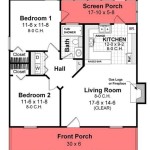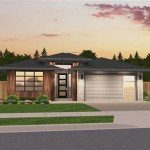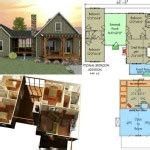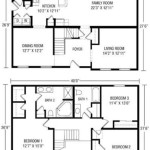Build Your Dream Home: House Design Plans For Every Style
Embarking on the journey of building a home is a significant undertaking, one that demands careful planning and consideration. At the heart of this process lies the house design plan, a blueprint that translates dreams into tangible structures. The availability of diverse design plans caters to a wide spectrum of architectural preferences, lifestyle needs, and budgetary constraints. Understanding the options available and the factors influencing these designs is crucial for a successful home-building endeavor.
The selection of a house design plan is more than simply choosing an aesthetic. It involves a comprehensive evaluation of functionality, spatial arrangement, and long-term suitability. The design must align with the homeowner's lifestyle, incorporating features that enhance daily living and accommodate future changes. Furthermore, the chosen plan should comply with local building codes and regulations, ensuring safety and structural integrity.
Understanding Architectural Styles and Their Influence on House Design Plans
Architectural styles serve as a foundational element in house design, dictating the overall aesthetic and character of a dwelling. Each style possesses distinct characteristics, influencing the form, materials, and detailing used in the construction. Familiarizing oneself with common styles is essential for selecting a design plan that reflects personal preferences and complements the surrounding environment.
One prevalent style is the traditional Colonial, characterized by its symmetrical facade, centered entry, and evenly spaced windows. Colonial homes often feature a formal layout with distinct living and dining areas. These designs typically incorporate classic detailing, such as pilasters, crown molding, and dormer windows. While offering a timeless appeal, traditional Colonial styles may require larger lots and can be more expensive to build due to their intricate detailing.
In contrast, the Craftsman style emphasizes natural materials, handcrafted details, and open floor plans. Common features include exposed rafters, wide eaves, and prominent porches. Craftsman homes are often designed with sustainable practices in mind, utilizing energy-efficient materials and passive solar strategies. This style offers a blend of comfort and practicality, appealing to those seeking a connection with nature and a relaxed living environment.
Modern architecture focuses on clean lines, minimalist detailing, and the integration of indoor and outdoor spaces. Modern homes often feature large windows, flat roofs, and open floor plans, emphasizing natural light and seamless transitions between living areas. The use of innovative materials, such as steel, glass, and concrete, is also common. Modern designs prioritize functionality and efficiency, creating spaces that are both visually appealing and environmentally responsible.
Beyond these established styles, numerous variations and hybrid approaches exist. Farmhouse style blends rustic charm with modern amenities, while Mediterranean designs evoke a sense of warmth and relaxation through stucco exteriors, tile roofs, and courtyards. Understanding the nuances of each style empowers homeowners to make informed decisions about the architectural direction of their dream home.
Key Factors to Consider When Choosing a House Design Plan
Selecting the right house design plan involves a careful assessment of several critical factors. These factors encompass not only the aesthetic preferences of the homeowner but also the practical considerations that will impact the functionality and cost of the home.
One of the most important factors is the size and layout of the home. The square footage should align with the homeowner's lifestyle and future needs. Consider the number of bedrooms and bathrooms required, the size of the living areas, and the need for specialized spaces like home offices or recreation rooms. The layout should promote efficient flow between rooms, maximizing functionality and minimizing wasted space. Open floor plans, while popular, may not be suitable for all lifestyles, as they can lack privacy and require careful consideration of sound transmission.
Budget is another crucial consideration. The cost of building a home can vary significantly depending on the design plan, the materials used, and the labor involved. Before committing to a specific plan, it is essential to obtain detailed cost estimates from reputable builders and suppliers. Consider potential cost-saving strategies, such as simplifying the design, using readily available materials, and phasing the construction process. It is also important to factor in ongoing costs, such as property taxes, insurance, and maintenance.
The location of the property also plays a significant role in the choice of a house design plan. Consider the climate, topography, and surrounding environment. In areas with harsh weather conditions, the design should incorporate features that provide protection from the elements, such as durable roofing materials, energy-efficient windows, and well-insulated walls. The topography of the site can also influence the design, dictating the placement of the home, the need for retaining walls, and the accessibility of outdoor spaces. Finally, the design should complement the surrounding environment, preserving natural features and minimizing the impact on the landscape.
Exploring Different Types of House Design Plans
House design plans are not monolithic; they come in a variety of formats and levels of detail, each serving a different purpose. Understanding the different types of plans available is crucial for navigating the design process effectively.
Preliminary design plans, also known as concept plans, are the initial sketches that outline the basic layout and aesthetic of the home. These plans are typically used to explore different design options and to refine the overall vision. Preliminary plans are not intended for construction purposes but rather to visualize the potential of the project and to gather feedback from stakeholders.
Schematic design plans build upon the preliminary plans, providing more detailed information about the building's form, massing, and spatial relationships. These plans typically include floor plans, elevations, and site plans, but they lack the technical details required for construction. Schematic design plans are used to communicate the design intent to the homeowner and to obtain preliminary approvals from building officials.
Construction documents, also known as working drawings, are the most comprehensive type of house design plan. These plans contain all the information needed to build the home, including detailed floor plans, elevations, sections, structural drawings, and mechanical drawings. Construction documents also specify the materials, finishes, and fixtures to be used in the construction. These plans are essential for obtaining building permits and for guiding the construction process.
In addition to these standard types of plans, some homeowners may choose to hire an interior designer to create detailed interior design plans. These plans specify the layout of furniture, the selection of materials, and the design of lighting and electrical systems. Interior design plans can enhance the aesthetic appeal and functionality of the home, creating a cohesive and comfortable living environment.
Furthermore, the emergence of 3D modeling and virtual reality technologies has revolutionized the way house design plans are presented and experienced. These technologies allow homeowners to visualize their future home in a realistic and interactive manner, providing a better understanding of the design and facilitating informed decision-making. 3D models and virtual reality simulations can also be used to identify potential problems or design flaws before construction begins, saving time and money in the long run.
Ultimately, selecting the appropriate house design plan requires careful consideration of architectural styles, key factors, and the different types of plans available. Engaging with qualified architects and designers is crucial for transforming a vision into a buildable reality.

Discover Your Dream Home Creative Design Plans For Every Style

How To Design A House From Sketch Reality

Design Your Own House Floor Plans Roomsketcher

Dream House Plans Designs Customizable Home Floor

3 Bedroom House Plan Stylish Home Designs And Budgets In 2025

Free Simple Two Story House Plans Online Edit Available

Dream House Plans Designs Customizable Home Floor

Design Your Own House Floor Plans Roomsketcher

House Plans Floor Blueprints

Modern House Plans Floor Designs The Designers
Related Posts








